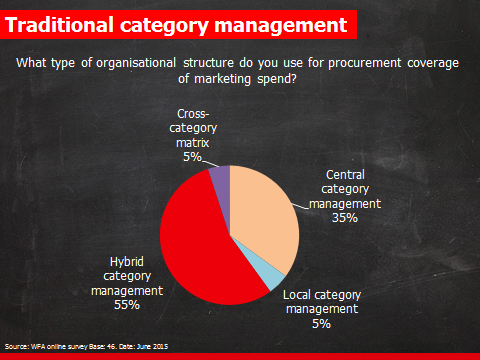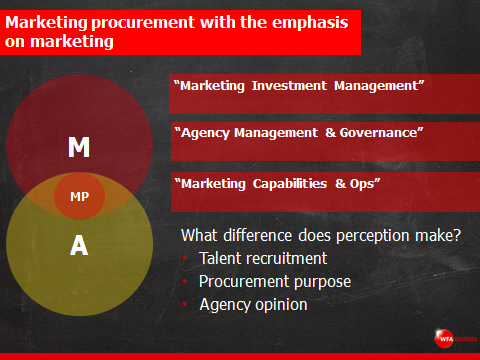
To say the news that a high profile brand owner recently scrapped its marketing procurement function has been met with a lot of comment amongst WFA sourcing members is something of an understatement.
“Is this a trend?” “Who else is considering this?” “What does this mean for the future of procurement?” are commonly what most people are asking.
In juxtaposition, the other question we get asked a lot (much more in fact)
is “We’re hiring. Do you know where we can find great marketing procurement talent?”.
Marketing procurement professionals shouldn’t panic. We’re not seeing scrapping of the function as a broader trend, and what’s more, across the 80 different global sourcing teams in WFA’s membership we are in fact seeing record highs in terms of clients recruiting for additional sourcing talent and growing their marketing procurement team. A conservative estimate would be that more than 30% of our members are looking for new people right now. So you could say that this is the exception that proves the rule.
Except that this glosses over a thorny issue. For this brand, procurement was clearly not seen to be adding sufficient value as a consultative, standalone function. Their processes have been set out and mapped and will be implemented by marketing from now on. The question being asked now is whether these processes will be able to be followed by resource-poor brand marketers. Time will tell.
However we interpret the motivation for this decision, it shows there is still much work needed to be done to demonstrate what effective marketing sourcing looks like. Despite most multinationals in WFA’s membership having a marketing sourcing department, the conversations during
SOURCINGFORUM meetings still frequently centre on how to demonstrate procurement value to marketing customers and to other internal stakeholders.
So how can procurement better articulate how it services brands? What do organisations need to do to help procurement succeed in its mission? Here are some suggestions that WFA members have discussed during recent sessions:
#1 Smarter splits of spend
There is significant evolution happening within the marketing procurement function right now. According to WFA
research, the traditional procurement technique of segmenting spend into categories (production, events, point-of-sale, etc.) is shifting towards a multi-category approach that reflects both integrated marketing approaches and also the pervasive creep of digital into all channels. The best marketing sourcing teams are changing with the times and are cannot be labelled as approaching marketing in classical procurement terms.
 #2 The right language
#2 The right language
Misapplication of procurement language can alienate a brand marketer and an agency faster than you can bid on an e-auction. When sourcing uses language like
RFI/RFP instead of
Brief or
Pitch c
redentials then in the eyes of brand owners it betrays its roots as a commercial cost consultant, irrespective of whether value is a consideration or not. To move beyond this simplistic example, language is constantly evolving and if it is to buy and source well, then procurement must be as fluent in the language used within the programmatic media buying space as agencies are. This requires
education around DMPs, DSPs and Trading Desks.
#3 Change of ownership
Forgetting costs for a moment, marketing sourcing’s job is most commonly to manage the agency governance process (from pitching through selection to performance assessment and remuneration). When we have looked at the future of marketing procurement, one emerging trend is that some marketing procurement teams are restructuring their reporting lines to report into marketing (the CMO) instead of the head of indirect procurement (or CPO). Although technically difficult and requiring some complicated internal restructuring, this is arguably a more natural fit for marketing sourcing given its actual role.
#4 Funded by the CMO
Rather than scrapping the function entirely, this is about embedding procurement people in marketing; in the same way for example that business/consumer intelligence is a marketing function. In essence, this means the CMO can co-fund the FTEs who cover marketing within the procurement function. Senior marketers are therefore more closely involved in the selection process and career path of this team, and naturally setting mutually beneficial objectives for the team.
#5 Align KPIs
When sourcing and marketing align their goals and work closely together it’s proven to be a win-win for the business. Closer alignment of KPIs between these two functions will help get the most of out of a brand’s external partners. This does not simply mean that procurement should have some similar brand growth metrics to marketing. It means that marketing should also share some of the financial targets that sourcing have. This does not just help foster a good working relationship; it helps face external partners with one voice and unified ways-of-working.

To conclude, rather than taking this as an ominous sign for sourcing, which all trends point against, we should take the opportunity to identify what procurement needs to succeed. Oversight on process and the ability to cover agency management responsibilities in an objective way (amongst the other services procurement provides) are part of an ongoing task that procurement is well placed to offer.
If we act as enablers for enlightened marketing procurement professionals who can run smart agency governance programmes and who define themselves as marketing financial management experts, then we will be putting sound procurement processes at the heart of the business relationship between brand and agency.
For more information on our
SOURCINGFORUM please contact
Steve Lightfoot.
 To say the news that a high profile brand owner recently scrapped its marketing procurement function has been met with a lot of comment amongst WFA sourcing members is something of an understatement. “Is this a trend?” “Who else is considering this?” “What does this mean for the future of procurement?” are commonly what most people are asking.
In juxtaposition, the other question we get asked a lot (much more in fact) is “We’re hiring. Do you know where we can find great marketing procurement talent?”.
Marketing procurement professionals shouldn’t panic. We’re not seeing scrapping of the function as a broader trend, and what’s more, across the 80 different global sourcing teams in WFA’s membership we are in fact seeing record highs in terms of clients recruiting for additional sourcing talent and growing their marketing procurement team. A conservative estimate would be that more than 30% of our members are looking for new people right now. So you could say that this is the exception that proves the rule.
Except that this glosses over a thorny issue. For this brand, procurement was clearly not seen to be adding sufficient value as a consultative, standalone function. Their processes have been set out and mapped and will be implemented by marketing from now on. The question being asked now is whether these processes will be able to be followed by resource-poor brand marketers. Time will tell.
However we interpret the motivation for this decision, it shows there is still much work needed to be done to demonstrate what effective marketing sourcing looks like. Despite most multinationals in WFA’s membership having a marketing sourcing department, the conversations during SOURCINGFORUM meetings still frequently centre on how to demonstrate procurement value to marketing customers and to other internal stakeholders.
So how can procurement better articulate how it services brands? What do organisations need to do to help procurement succeed in its mission? Here are some suggestions that WFA members have discussed during recent sessions:
#1 Smarter splits of spend
There is significant evolution happening within the marketing procurement function right now. According to WFA research, the traditional procurement technique of segmenting spend into categories (production, events, point-of-sale, etc.) is shifting towards a multi-category approach that reflects both integrated marketing approaches and also the pervasive creep of digital into all channels. The best marketing sourcing teams are changing with the times and are cannot be labelled as approaching marketing in classical procurement terms.
To say the news that a high profile brand owner recently scrapped its marketing procurement function has been met with a lot of comment amongst WFA sourcing members is something of an understatement. “Is this a trend?” “Who else is considering this?” “What does this mean for the future of procurement?” are commonly what most people are asking.
In juxtaposition, the other question we get asked a lot (much more in fact) is “We’re hiring. Do you know where we can find great marketing procurement talent?”.
Marketing procurement professionals shouldn’t panic. We’re not seeing scrapping of the function as a broader trend, and what’s more, across the 80 different global sourcing teams in WFA’s membership we are in fact seeing record highs in terms of clients recruiting for additional sourcing talent and growing their marketing procurement team. A conservative estimate would be that more than 30% of our members are looking for new people right now. So you could say that this is the exception that proves the rule.
Except that this glosses over a thorny issue. For this brand, procurement was clearly not seen to be adding sufficient value as a consultative, standalone function. Their processes have been set out and mapped and will be implemented by marketing from now on. The question being asked now is whether these processes will be able to be followed by resource-poor brand marketers. Time will tell.
However we interpret the motivation for this decision, it shows there is still much work needed to be done to demonstrate what effective marketing sourcing looks like. Despite most multinationals in WFA’s membership having a marketing sourcing department, the conversations during SOURCINGFORUM meetings still frequently centre on how to demonstrate procurement value to marketing customers and to other internal stakeholders.
So how can procurement better articulate how it services brands? What do organisations need to do to help procurement succeed in its mission? Here are some suggestions that WFA members have discussed during recent sessions:
#1 Smarter splits of spend
There is significant evolution happening within the marketing procurement function right now. According to WFA research, the traditional procurement technique of segmenting spend into categories (production, events, point-of-sale, etc.) is shifting towards a multi-category approach that reflects both integrated marketing approaches and also the pervasive creep of digital into all channels. The best marketing sourcing teams are changing with the times and are cannot be labelled as approaching marketing in classical procurement terms.
 #2 The right language
Misapplication of procurement language can alienate a brand marketer and an agency faster than you can bid on an e-auction. When sourcing uses language like RFI/RFP instead of Brief or Pitch credentials then in the eyes of brand owners it betrays its roots as a commercial cost consultant, irrespective of whether value is a consideration or not. To move beyond this simplistic example, language is constantly evolving and if it is to buy and source well, then procurement must be as fluent in the language used within the programmatic media buying space as agencies are. This requires education around DMPs, DSPs and Trading Desks.
#3 Change of ownership
Forgetting costs for a moment, marketing sourcing’s job is most commonly to manage the agency governance process (from pitching through selection to performance assessment and remuneration). When we have looked at the future of marketing procurement, one emerging trend is that some marketing procurement teams are restructuring their reporting lines to report into marketing (the CMO) instead of the head of indirect procurement (or CPO). Although technically difficult and requiring some complicated internal restructuring, this is arguably a more natural fit for marketing sourcing given its actual role.
#4 Funded by the CMO
Rather than scrapping the function entirely, this is about embedding procurement people in marketing; in the same way for example that business/consumer intelligence is a marketing function. In essence, this means the CMO can co-fund the FTEs who cover marketing within the procurement function. Senior marketers are therefore more closely involved in the selection process and career path of this team, and naturally setting mutually beneficial objectives for the team.
#5 Align KPIs
When sourcing and marketing align their goals and work closely together it’s proven to be a win-win for the business. Closer alignment of KPIs between these two functions will help get the most of out of a brand’s external partners. This does not simply mean that procurement should have some similar brand growth metrics to marketing. It means that marketing should also share some of the financial targets that sourcing have. This does not just help foster a good working relationship; it helps face external partners with one voice and unified ways-of-working.
#2 The right language
Misapplication of procurement language can alienate a brand marketer and an agency faster than you can bid on an e-auction. When sourcing uses language like RFI/RFP instead of Brief or Pitch credentials then in the eyes of brand owners it betrays its roots as a commercial cost consultant, irrespective of whether value is a consideration or not. To move beyond this simplistic example, language is constantly evolving and if it is to buy and source well, then procurement must be as fluent in the language used within the programmatic media buying space as agencies are. This requires education around DMPs, DSPs and Trading Desks.
#3 Change of ownership
Forgetting costs for a moment, marketing sourcing’s job is most commonly to manage the agency governance process (from pitching through selection to performance assessment and remuneration). When we have looked at the future of marketing procurement, one emerging trend is that some marketing procurement teams are restructuring their reporting lines to report into marketing (the CMO) instead of the head of indirect procurement (or CPO). Although technically difficult and requiring some complicated internal restructuring, this is arguably a more natural fit for marketing sourcing given its actual role.
#4 Funded by the CMO
Rather than scrapping the function entirely, this is about embedding procurement people in marketing; in the same way for example that business/consumer intelligence is a marketing function. In essence, this means the CMO can co-fund the FTEs who cover marketing within the procurement function. Senior marketers are therefore more closely involved in the selection process and career path of this team, and naturally setting mutually beneficial objectives for the team.
#5 Align KPIs
When sourcing and marketing align their goals and work closely together it’s proven to be a win-win for the business. Closer alignment of KPIs between these two functions will help get the most of out of a brand’s external partners. This does not simply mean that procurement should have some similar brand growth metrics to marketing. It means that marketing should also share some of the financial targets that sourcing have. This does not just help foster a good working relationship; it helps face external partners with one voice and unified ways-of-working.
 To conclude, rather than taking this as an ominous sign for sourcing, which all trends point against, we should take the opportunity to identify what procurement needs to succeed. Oversight on process and the ability to cover agency management responsibilities in an objective way (amongst the other services procurement provides) are part of an ongoing task that procurement is well placed to offer.
If we act as enablers for enlightened marketing procurement professionals who can run smart agency governance programmes and who define themselves as marketing financial management experts, then we will be putting sound procurement processes at the heart of the business relationship between brand and agency.
For more information on our SOURCINGFORUM please contact Steve Lightfoot.
To conclude, rather than taking this as an ominous sign for sourcing, which all trends point against, we should take the opportunity to identify what procurement needs to succeed. Oversight on process and the ability to cover agency management responsibilities in an objective way (amongst the other services procurement provides) are part of an ongoing task that procurement is well placed to offer.
If we act as enablers for enlightened marketing procurement professionals who can run smart agency governance programmes and who define themselves as marketing financial management experts, then we will be putting sound procurement processes at the heart of the business relationship between brand and agency.
For more information on our SOURCINGFORUM please contact Steve Lightfoot.


